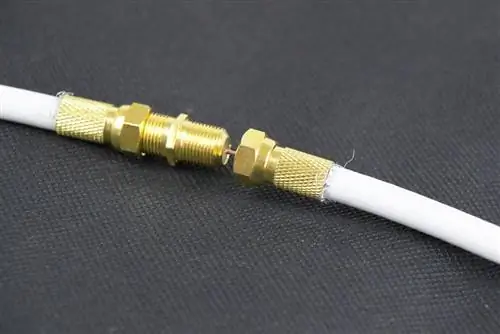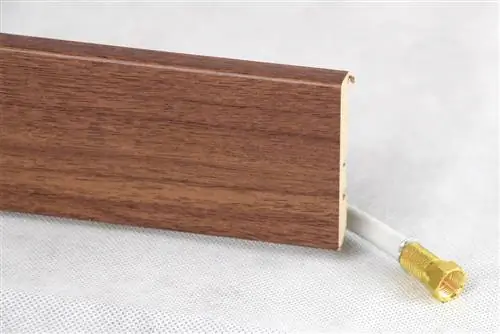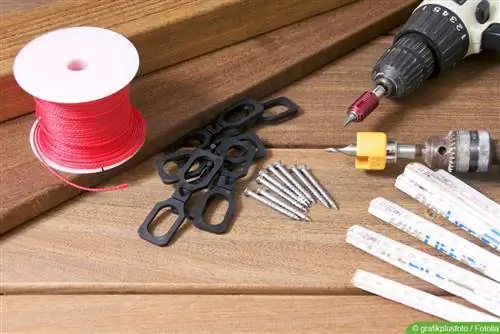- Author admin [email protected].
- Public 2023-12-17 03:39.
- Last modified 2025-01-24 12:45.
If you want to lay TV and satellite cables yourself, you should attach great importance to high-quality materials. The cheap alternatives often emit electromagnetic radiation that is too strong, which has a negative impact on transmission and reception. In addition, the satellite dish (correct: satellite dish) and the receiver are in most cases high-priced devices that require an appropriate connection.
Instructions for satellite reception
The analogue satellite transmission was switched off a few years ago, but today it is only available digitally. This requires various devices and types of cables to convert the digital signals into images on the end device. With the right cables, several receivers can be connected directly and in this way supply a house with different parties. In general, electrical installations may only be carried out by trained specialists. With the right instructions, even experienced DIY enthusiasts can do this job. However, an electrician should then carry out a safety check at the end of the work.
- An HDMI-capable television with a flat screen is ideal
- A satellite dish is required for reception
- A suitable digital receiver is required
- A LNB (low-noise signal converter) is also necessary
- This converter also acts as an amplifier for the signals
- Coaxial cable to connect the LNB to the receiver
Tip:
Depending on the number of participating receivers, a distinction is made between various LNB models. The single LNB is only suitable for one participant, but the twin LNB can serve up to two participants. The Quad LNB even enables a connection of four to eight participants.
High quality sheathing
An important aspect when laying TV and satellite cables is the shielding, or more precisely the sheathing of the conductors in the respective cable system. This coating prevents the electromagnetic radiation that occurs during use from having a negative impact on transmission and reception. In most cases, the antenna cables stretch many meters across the entire house to reach the satellite dish on the roof. Due to this very long installation, interference radiation can quickly develop.
- To avoid excessively strong electromagnetic radiation by shielding
- These rays can be minimized by coverings
- The longer the cable, the higher the radiation levels
- Robust cables are important
- Nylon sheaths make the cable systems extremely durable
Materials for contacts

In addition to the quality of the cables, the contacts on the respective interfaces of the devices are also crucial. This includes the television, satellite receiver and, more recently, the DVB-T receiver so that you can experience all the programs on the screen in razor-sharp HD quality. In addition, the connection between the contacts, the cables and the devices should be permanently stable. In this way, frequent plugging and unplugging cannot harm them.
- Pay attention to high-quality contacts
- Inferior goods lead to data loss during transmission
- The plug and socket should be made of the same material
- High-performance precious metals are recommended
- Gold in particular is an excellent conductor
Special cable
If you don't want to drill holes in the house walls and window frames for the antenna cable, you should think about purchasing special cables. These press into the seal when the window is closed or can be conveniently laid under the door frame. The special cables only serve as an additional connection to the satellite dish and receiver. In addition, the user has a variety of models to choose from when it comes to the performance of the cables. If the television is already HDMI-capable, a simple antenna cable is no longer sufficient to connect it to the rest of the system.
- Using special cables can prevent holes
- Thanks to flat properties, no drilling is necessary
- Flat cable is approx. 20 cm long
- Special cable serves as an extension to the normal antenna cable
- Use HDMI-capable conductors for corresponding devices
Tip:
Flat cables with a thickness of 3 mm are ideal in order to maintain good image quality. If the special cable is not thick enough, the picture often deteriorates.
Laying cables

There are different options when laying a cable. If you don't want this to be visible, you can place it under or in the plaster of the walls. However, this method has various disadvantages, including considerable additional work. In addition, the wall in this area must be torn up for subsequent changes and maintenance work. In this way, the costs of the installation add up as the affected wall needs to be repaired. In most cases, the cables are laid later, so this solution is only possible to a limited extent. If you only lay the cables loosely, you risk them becoming a dangerous tripping hazard.
- Laying in plaster is laborious
- First you need to create slots for the cables
- Then the openings are filled in
- Walls must then be re-papered or plastered
- Laying a cable with shielded sheathed cables is easy
- Cables can find their place within a cable strip on the plaster
- Alternatively, these can be integrated into the bases of the floors
- Never lay out cables openly as they are quickly damaged






